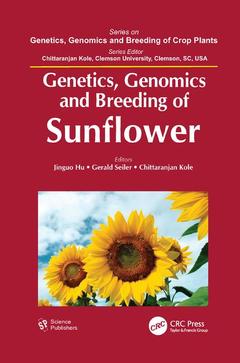Genetics, Genomics and Breeding of Sunflower Genetics, Genomics and Breeding of Crop Plants Series

The sunflower has fascinated mankind for centuries. The oilseed sunflower contributes approximately ten percent of the world?s plant-derived edible oil and the confection type sunflower holds a considerable share of the directly consumed snacks market. In addition, sunflower is also grown as an ornamental for cut flowers, as well as in home gardens. We are now embarking on the age of genomics which will expedite the process of genetic improvement of crops. There has been an explosion of information on genetic markers, DNA sequences, and genomic resources for most major food crops including sunflower. This volume is intended to bridge traditional research with modern molecular investigations on sunflower.
Basic Information: Economic Importance; Crop History; Botanical Description; Genetic Resources; Importance as a Model Plant; Conclusions; Classic Genetics and Breeding: Hybrids; Breeding Methods; Breeding Objectives; Classic Genetic Mapping and Cytogenetics; Interest of Molecular Maps and Knowledge of Genomics for Conventional Genetics and Breeding; The Introduction of Genomics in Breeding since 1995; GeneticLinkage Maps: Strategies, Resources and Achievements: Brief History of Mapping Efforts: Morphological and Biochemical Markers; DNA-based Marker Techniques; Mapping Populations and Tools; Achievement; Published Sunflower Linkage Maps; Challenges; Mapping and Tagging of Simply Inherited Traits: Disease Resistances; Herbicide Resistance; Male Sterility; Morphological Traits; Seed Quality; Molecular Mapping of Complex Traits: Identification Trait Loci Quantitative; Conclusion; Gene Cloning and Characterization: Map-based Cloning Approaches in Sunflower; Candidate Gene Approaches based on Homology to Genes of Other Species; Verification of Candidate Genes and Functional Analyses of Genes; Conclusion; Molecular Breeding: Overview of Components and Objectives for Molecular Breeding; Germplasm Characterization; Molecular Strategies to Create and Identify Novel Variation; Marker-assisted Selection; Molecular Breeding in Private Sector Breeding Programs; Limitations and Prospects of MAS; Oil Composition Variations: Mutations Leading to One Main Fatty Acid Accumulated in Oil; Tocopherols; Phytosterols; Acknowledgements; Transgenic Sunflower: Released Transgenic Crops; Transgenic Sunflower; Overcoming of Crop Constraints through Transgenic Sunflower and New Products; Debate about Transgenic Sunflower; Prospective View on Transgenic Sunflower Release. Future Prospects: The Past; Future Potential to Increase Productivity; Impact of Advances in Sunflower Genomics; Future Potential to Expand into Other Geographical Areas; New Uses; Outlook. Each section includes an Introduction and References.
Editors:
Jinguo Hu: USDA-Agricultural Research Service, Washington State University, Pullman, Washington, USA
Gerald Seiler: USDA, Northern Crop Science Laboratory, Fargo, North Dakota, USA
Chittaranjan Kole: Department of Genetics and Biochemistry, Clemson University, South Carolina, USA
Date de parution : 06-2017
15.2x22.9 cm
Date de parution : 06-2010
Ouvrage de 360 p.
15.2x22.9 cm
Disponible chez l'éditeur (délai d'approvisionnement : 15 jours).
Prix indicatif 232,80 €
Ajouter au panierThèmes de Genetics, Genomics and Breeding of Sunflower :
Mots-clés :
Classic Genetics and Breeding:; Genetic Linkage Maps: Strategies; Resources and Achievements; Mapping and Tagging of Simply Inherited Traits; Molecular Mapping of Complex Traits; Gene Cloning and Characterization; Downy Mildew; SSR Marker; Tourvieille De Labrouhe; Cm; Oleoyl Phosphatidyl Choline Desaturase; Wild Sunflowers; Sunflower Genome; Inbred Lines; RIL Population; Sunflower Production; DNA Marker; Seed Oil Concentration; Sunflower Oil; Wild Sunflower Species; Sunflower Inbred Lines; Acyl Carrier Protein; Downy Mildew Resistance; Mapping Population; Linkage Groups; Male Sterility; Oil Content; Oleate Desaturase; Heat Shock; LIM Protein; LOD Score



